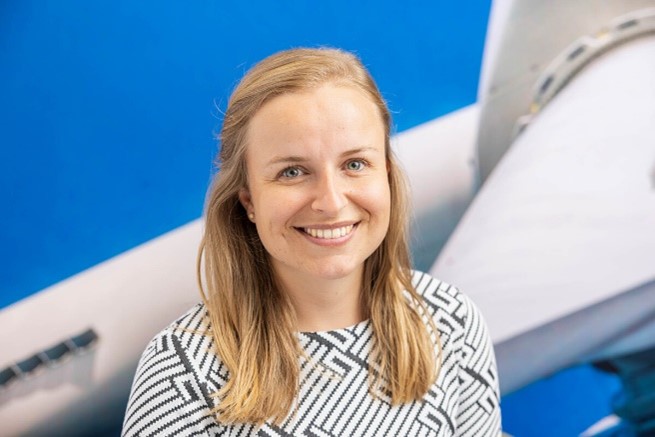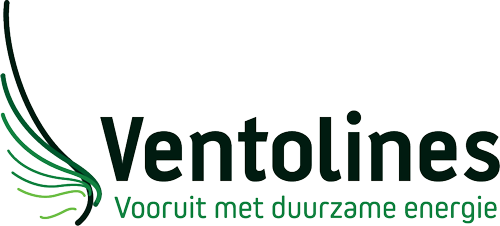Maaike Sickler recounts how the lights of Windpark Fryslân were successfully switched off

We recently shared the news that the lights at Windpark Fryslân may be switched off at night thanks to the implementation of an proximity detection system, the first of its kind in the Netherlands for a wind farm. In this interview, we recount how we achieved this. It involved 12 years of finding solutions where there seemed to be none. That tenacity is typical of Ventolines, says project engineer Maaike Sickler.
Executive summary
- An aviation radar detects approaching aircraft and controls the lighting of the turbines.
- As long as no aircraft are nearby, the lighting remains completely off at night.
- This innovative solution involved intensive collaboration with the suppliers of the radar, the lighting and the data system in the turbine.
- Ventolines has worked for years with various authorities to adapt regulations and obtain permits.
The power of connectivity
It took 12 years of intense teamwork, connectivity and, above all, tenacity to pull it off, but the result was worth all that effort. As of 15 February, the lights may be switched off in Windpark Fryslân, the world’s largest wind farm in an inland water. People in Makkum, Workum and Hindeloopen can once again see the dark sky over the IJsselmeer at night, while still ensuring safety if an aircraft approaches.
Important step
If an aircraft approaches Windpark Fryslân, an aviation radar detects it and transmits a signal to the turbines to temporarily switch on the lights. It’s an important step, because this project has also simplified the path to implementing approach detection for other wind farms.
“When we started this, there were no regulations for turning off wind turbine lights.”
– Maaike Sickler, Project Engineer Ventolines
Many parties involved
What does it take to get this done, in terms of technology and regulations? Maaike Sickler, project engineer at Ventolines and closely involved in this project for the past three years, explains. ‘Many parties are involved and necessary to achieve this’, says Sickler. ‘When we first began, no regulations were yet in place for turning off wind turbine lights. Furthermore, several permits are needed, such as a frequency permit, a building permit and an amendment to the environmental permit.’
Web of stakeholders
Sickler: ‘We formed a comprehensive network of stakeholders with whom we collaborated towards this objective. A power connection was needed, for instance, and a foundation for the radar – for this we worked with civil subcontractor Dura Vermeer Jansma. For the radar technology, we worked with Danish supplier Terma. We had a specialist from Ventolines in the team on SCADA and wind farm communications. The turbines are from Siemens Renewable Energy, but the lighting comes from subcontractor Orga / Sabik. Our specialists worked with all these suppliers to ensure that the Terma aviation radar relays signals to the Orga lighting of the turbines via the SCADA system.’
Regulation and safety
Regulatory and safety requirements also required many parties before the lights could be switched off. Sickler: ‘We were in talks with the Inspectorate for the Environment and Transport (ILT) and the Dutch Authority for Digital Infrastructure for a long time. Safety is paramount. We worked with the Netherlands Aerospace Centre (NLR) to draw up the flight plan and carry out flight tests. This ensures that all systems interact reliably.’
Sickler: ‘With Rijkswaterstaat, we ensured that the dike on which the radar was to be placed would not be negatively impacted. After all, for the foundation we had to work in the dike and we had to be able to guarantee dike safety at all times. We discussed the lighting plan with the municipality. It helps that we already had good relationships with these parties, as we also had the development and construction of Windpark Fryslân under our belt.’
“We are a company that thinks: it doesn’t exist yet, so let’s see if it can be done. We keep finding solutions where there don’t seem to be any. That’s exactly what motivates us.”
– Maaike Sickler, project engineer Ventolines
Maintaining dialogue
Up until the final weeks before implementation of the radar, it was uncertain whether it would succeed. For years, we maintained dialogue with all parties. We kept coming up with new proposals and looking for ways to make the result for local residents even better.
Minimising light duration
Maaike Sickler: ‘Initially, for instance, the lights had to stay on for quite a long time after an aircraft had left the warning zone. Longer than we considered necessary for aviation safety. So we sat down with ILT to reduce that time. That had to be adjusted in the information sheet, which contains the regulations you have to comply with if you want to use radar detection for wind farms. So we really go above and beyond to reduce the impact on the surrounding area as much as possible. If I lived near a wind farm, I wouldn’t want to see red lights all the time either.’
Finding solutions where there don’t seem to be any
That tenacity is characteristic of Ventolines, says Maaike Sickler: We are a company that thinks: it doesn’t exist yet, so let’s see if it can be done, rather than waiting until the regulations are changed. We keep coming up with inventive ideas to simplify things, and finding solutions where there don’t seem to be any. That’s exactly what motivates us.’
Meet Ventolines
Are you working on a project in renewable energy that is so complex that it seems virtually impossible? Feel free to get in touch to exchange views. Email our expert, or call the central Ventolines number. A short video meeting to get to know Maaike Sickler or one of the other Ventolines specialists is, of course, also possible.
View an animation about the lighting of the wind park here:
Ventolines has the in-house expertise to manage all aspects of your sustainable energy project. From feasibility study to construction, and from contracting to asset management. Battery projects mainly concern:
Development of sketches
and studies to feasibility
Legal advice about
all aspects of new energy
Contracting advice
and integrated strategies

